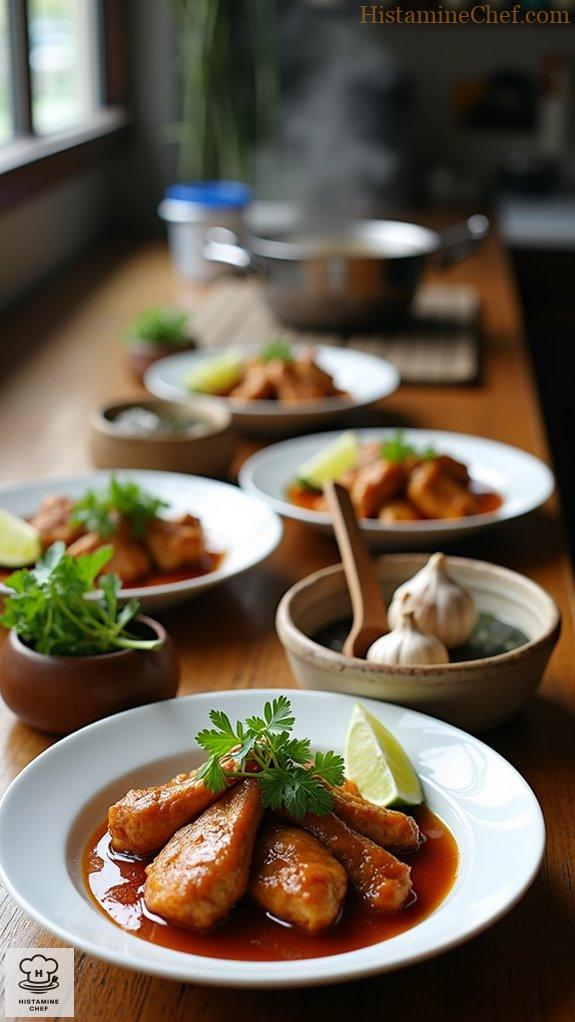When I think of Filipino street food, Adobo instantly pops up—that savory, mouthwatering dish that showcases our rich culinary heritage. But if you’re dealing with histamine intolerance, don’t fret! You can whip up a fabulous version using fresh chicken, distilled vinegar, and coconut aminos instead of soy sauce. Picture simmering it all together, filling your kitchen with irresistible aromas. Curious about how to make it perfect at home? Let’s dig into some flavorful adjustments that’ll impress your taste buds!
Vibrant Street Life Experience

The street food culture in the Philippines, particularly in bustling cities like Manila, is a vibrant tapestry of flavors and traditions that reflect the country’s rich culinary heritage.
Street vendors, often found on busy sidewalks and public markets, serve an array of dishes that range from savory to sweet, attracting locals and tourists alike. Cooking street food has deep historical roots in the Philippines, dating back to pre-colonial times when the trade of food became a communal experience.
As various cultures, including Spanish and Chinese, influenced Filipino cuisine over the centuries, street food evolved to incorporate unique ingredients and cooking methods. Dishes like lumpia, kakanin, and, of course, adobo—considered a national dish—are staples that showcase the local palate.
The convenience and affordability of street food make it a beloved option for many, often reflecting the spirit of Filipino hospitality. Today, bustling food markets come alive with the sizzling sounds of cooking and the enticing aromas of marinated meats and grilled skewers, creating an unforgettable ambiance that invites everyone to partake in the culinary adventure that embodies the essence of Filipino life.
Simmered in Giant Cauldrons

Street vendors cook Homemade Filipino Adobo by marinating meat, usually chicken or pork, in a mix of soy sauce and vinegar, along with garlic, bay leaves, and pepper.
They use large cauldrons over an open flame for simmering, allowing the meat to absorb the flavors while the cauldron’s heat generates a rich aroma. As the mixture bubbles, vendors frequently stir to prevent any sticking at the bottom and to guarantee that the sauce thickens evenly, creating a glossy finish.
This method of cooking not only enhances the flavor but also speeds up the cooking process, making it ready to serve quickly to enthusiastic customers.
Ingredients Needed:
- 1 kg chicken or pork
- 1 cup soy sauce
- 1 cup vinegar
- 5 cloves garlic, minced
- 3 bay leaves
- 1 teaspoon pepper
- 1 tablespoon sugar (optional)
- Water (as needed)
Cooking Steps:
- Marinate meat in soy sauce.
- Add vinegar, garlic, and bay leaves.
- Let it sit for 30 minutes.
- Heat cauldron over open flame.
- Add marinated meat to the cauldron.
- Pour in any remaining marinade.
- Simmer until meat is tender.
- Stir occasionally until sauce thickens.
Cook With Fresh Ingredients

To make a homemade version of Filipino Adobo, start by selecting fresh chicken or pork (avoid processed meats).
Marinate the meat in a mixture of distilled white vinegar, soy sauce (omit if restricted), and water. Add chopped young garlic and bay leaves for authentic flavor.
Simmer the marinated meat in a pot, letting it cook slowly until tender. To enhance taste, add sweeteners like agave or maple syrup, but avoid any artificial sweeteners.
Serve with allowed starches like rice, quinoa, or sweet potatoes, freshly cooked, and top with fresh herbs, and avoid any restricted seasonings.
Cooking Steps:
- Marinate meat in vinegar and water
- Omit soy sauce if restricted
- Use young garlic and bay leaves
- Simmer until meat is tender
- Add sweeteners like agave
- Serve with allowed starches
- Top with fresh herbs
Low Histamine Variation of Adobo

Histamine intolerance can complicate enjoying street food, as many popular options are high in histamine, limiting choices. Moreover, street food is often made with preserved or fermented ingredients, which can exacerbate symptoms in sensitive individuals. Consequently, being aware of histamine levels in street food is vital for those affected. Eating street food like Filipino Adobo poses a challenge for individuals with histamine intolerance. Traditional recipes often include ingredients like vinegar, soy sauce, and marinated meats, which rank high on the SIGHI list, making them restricted. These ingredients can trigger symptoms such as headaches, hives, and digestive issues. As a result, it’s important to adapt the recipe to lower histamine options to enjoy this dish safely. Smart cooking techniques can aid in reducing histamine levels and improving safety for sensitive individuals. Incorporating low-histamine ingredient substitutions can further enhance the dish’s suitability.
Low Histamine Variation of Filipino Adobo – Cooking Instructions:
- Use fresh chicken or fresh meat without marinades for low histamine.
- Substitute regular vinegar with distilled white vinegar or apple vinegar.
- Omit soy sauce entirely; use a dash of coconut aminos instead.
- Avoid garlic and onion; season with non-restricted herbs like bay leaves.
- Replace traditional pepper with herbs to maintain flavor without the restriction.
- Cook meat in distilled white vinegar, water, and chosen spices.
- Simmer meat thoroughly until tender in moderate heat and moisture.
- Serve with freshly cooked rice, such as jasmine or basmati rice.
- Garnish with slices of allowed fruits like mango or peach if desired.
- Enjoy immediately to promote freshness and prevent histamine build-up.
Video Summary
Adobo is a traditional Filipino dish originating from the Spanish influence in the Philippines.
Today, we’ll explore two versions of this beloved meal: the authentic street version and a home-friendly low histamine variation.
Street vendors make adobo with a vibrant blend of flavors. They marinate chicken or pork in soy sauce, vinegar, garlic, and bay leaves. This mixture is then simmered for hours, creating a savory, tender dish.
Vendors often serve it with rice, making it a satisfying meal. They use large pots, bringing the community together for sharing. The aroma wafts through the streets, drawing hungry customers in.
For the home version, we’ll make a few simple changes. Start by replacing soy sauce with coconut aminos to reduce histamines. Use fresh chicken or pork, ensuring it’s pure and not processed.
For marinade, combine coconut aminos, apple vinegar, and crushed garlic. Marinate your meat for at least thirty minutes in a mixing bowl for the best flavor.
In a large pot, heat coconut oil over medium heat. Add the marinated meat and brown it on all sides. Then, add water and bay leaves to the pot. Cover and let it simmer on low heat for forty-five minutes to an hour.
Remove from heat when the meat is tender. Serve it with rice or quinoa for a heartier meal.
The low histamine adobo still offers a delicious blend of flavors. Its savory taste and tender texture will satisfy your cravings without discomfort.
Check the link in the description for the full recipe.


Leave a Reply